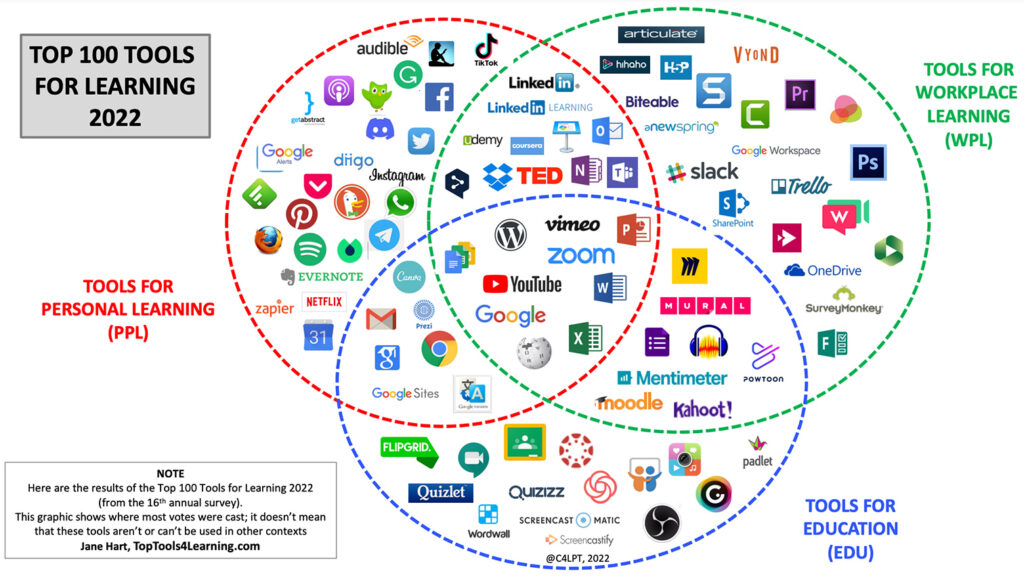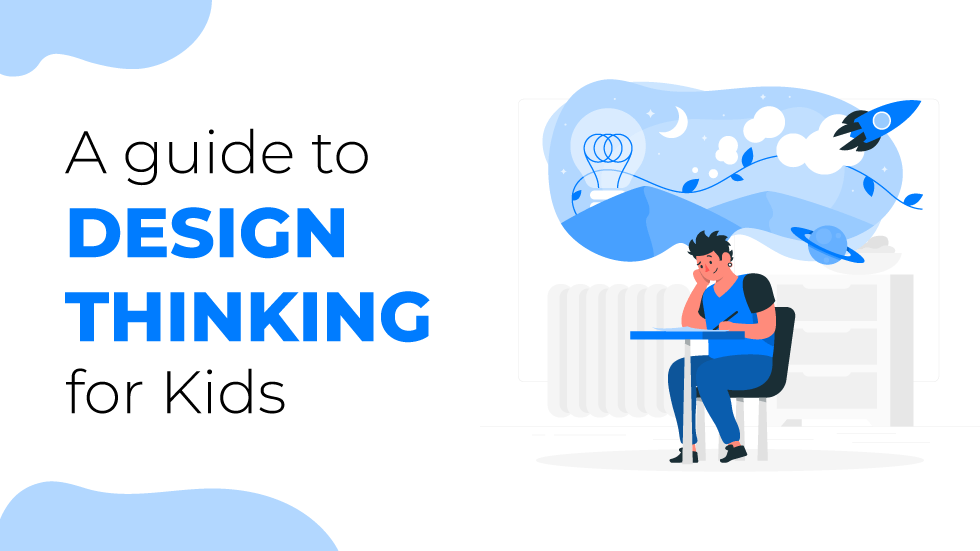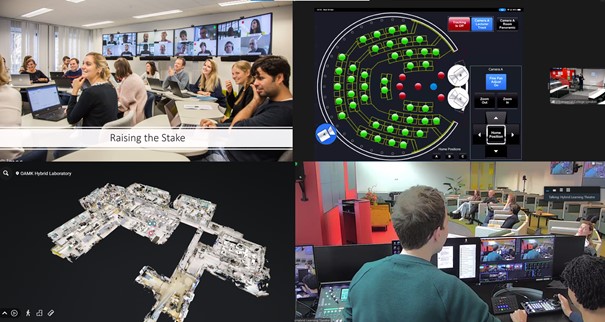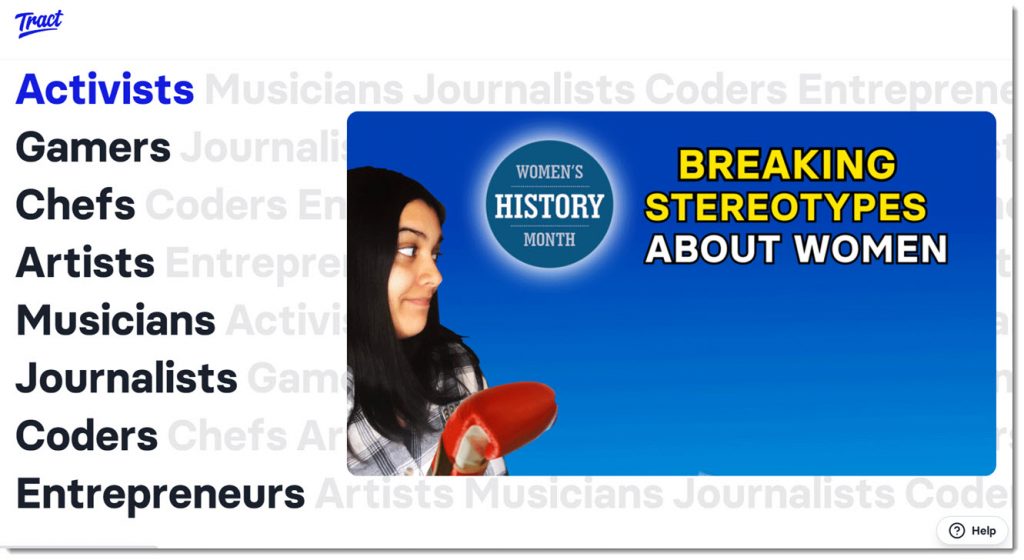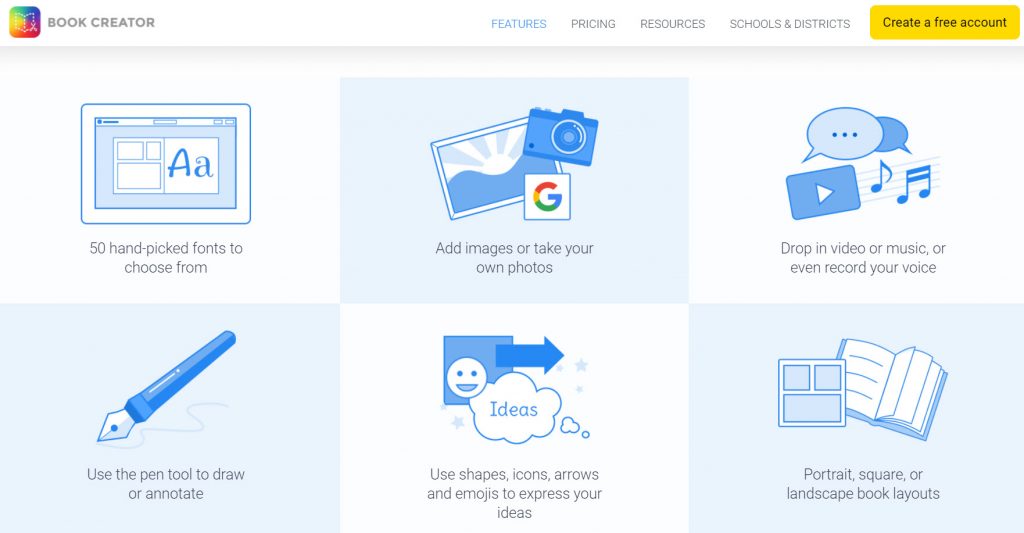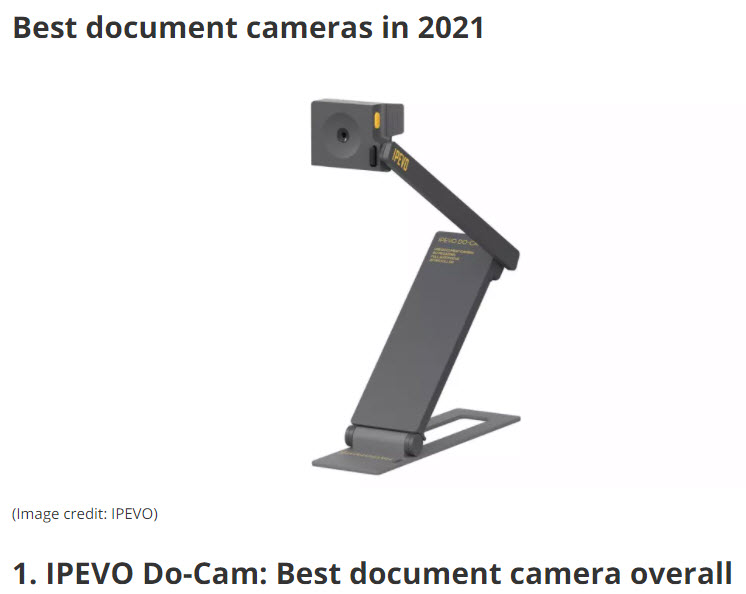From DSC:
The Ultimate List of 21-Century Skills – 2022 that’s on that page lists fifty skills. Whew! That’s a lot of skills. I doubt anyone will have them all. But the posting/infographic has a lot of fodder for further reflection and growth.
Top tools for learning 2022 — from toptools4learning.com by Jane Hart
Excerpt:
In fact, it has become clear that whilst 2021 was the year of experimentation – with an explosion of tools being used as people tried out new things, 2022 has been the year of consolidation – with people reverting to their trusty old favourites. In fact, many of the tools that were knocked off their perches in 2021, have now recovered their lost ground this year.
Also somewhat relevant/see:
- Tech & Learning Names Winners of the Best for Back to School 2022 Awards — from techlearning.com
The best education technology tools and solutions for back to school 2022
Yale Study: Vast Majority of High Schoolers Unhappy at School — from fee.org by Kerry McDonald
The Yale findings echo previous conclusions about young people’s attitudes toward school.
Excerpt:
Most high school students are not happy at school. A new study by Yale researchers finds that nearly three-quarters of high schoolers report negative feelings toward school. The study surveyed more than 20,000 high school students in all 50 US states and found widespread dissatisfaction at school across all demographic groups, with girls reporting slightly more negative emotions than boys. According to Yale co-author Zorana Ivcevic,
It was higher than we expected. We know from talking to students that they are feeling tired, stressed, and bored, but were surprised by how overwhelming it was.
From DSC:
If you were to have polled him during his ninth through eleventh-grade years, our son would have been one of the very disgruntled students going through high school. His senior year was spent doing exactly what he wanted to be doing — and he was much happier, more engaged, and more motivated to learn the material. He was also around an entirely different student body his senior year — where students were there because they wanted to be there and they were all pursuing their craft.
Fast forward a couple of years, and he actually enjoyed a good deal of his learning experiences this summer and he’s really looking forward to his film and acting classes this fall. It’s amazing the amount of energy and determination/interest that gets unleashed when the motivation is intrinsic.
.

Also from fee.org by Kerry McDonald:
- How Disruptive Innovation Is Accelerating the Growth of Alternative Learning Models
Disruptive innovation is reshaping how children learn and expanding access to alternative education models.
.
9 Digital Etiquette Tips — from techlearning.com by Lisa Nielsen
Teaching proper digital etiquette to students starts with modeling it
Excerpt:
It’s undeniable that the pandemic changed the way we teach, learn, work, and live, but when some people returned to in-person learning and their schools, it seemed they could use some advice on digital etiquette for the new, and extremely connected, world in which we are now operating. This is a world where at any time you may be meeting or teaching in-person, via video, phone, or a combination thereof at the same time.
While adapting was easier for some, others could use a bit of help. For those people, you may want to share or discuss these tips with them.
A Guide To Design Thinking For Kids — from edtechreview.in by Saniya Khan
Excerpt:
The concept is active and inclusive. What’s more, children embrace design thinking with enthusiasm. Across the globe, schools are embracing design thinking as a new way to learn and increase student participation. It should be on our education agenda. Of course, this is more complicated than standard repackaged evaluations. However, conceptual thinking gives children golden opportunities for commitment and creativity, two prerequisites for true learning.
.
How Accredible Makes Learning Credible — from gettingsmart.com by Tom Vander Ark
Key Points
- To increase the value of credentials, Accredible launched Spotlight Directory.
- This allows issuers to provide a home base for people that hold their credentials.
Excerpts:
Learners store credentials in their Accredible wallet and can incorporate them into their LinkedIn profile.
To increase the value of credentials, Accredible launched Spotlight Directory which allows issuers to provide a home base for people that hold their credentials. For example, the Hootsuite Certified Professionals Directory showcases everyone that has earned a Hootsuite credential.
The faster the world of work changes, the more the transcripts lose signal value and the more we need finer grained and more dynamic ways of communicating capabilities.
Tom Vander Ark
Addendum on 8/22/22:
What parents should say to teachers (according to teachers) — from washingtonpost.com by Elizabeth Chang
Excerpt:
“Parents are often surprised by stories of other parents’ treatment of teachers,” wrote Margaret Flaherty, 42, a high school English teacher at a public school in Byfield, Mass. “When I share some of the things parents have said or written to me, mouths go agape. They can be mean. Very mean. And we are so tired. Start with assuming good intentions and take it from there.”
The Metaverse Is Not a Place — from oreilly.com by Tim O’Reilly
It’s a communications medium.
Excerpt:
Foundations of the metaverse
You can continue this exercise by thinking about the metaverse as the combination of multiple technology trend vectors progressing at different speeds and coming from different directions, and pushing the overall vector forward (or backward) accordingly. No new technology is the product of a single vector.
So rather than settling on just “the metaverse is a communications medium,” think about the various technology vectors besides real-time communications that are coming together in the current moment. What news from the future might we be looking for?
- Virtual Reality/Augmented Reality…
- Social media…
- Gaming…
- AI…
- Cryptocurrencies and “Web3”…
- Identity…
#metaverse #AI #communications #gaming #socialmedia #cryptocurrencies #Web3 #identity #bots #XR #VR #emergingtechnologies
Coursera’s Global Skills Report
Excerpt from the Executive Summary:
Here are some of our top findings:
- Digital skills are the shared language of the modern economy.
- Women’s participation continued to rise.
- The developing world had the highest rate of learner growth.
- Lower levels of internet access mean lower levels of skills proficiency.
- Courses in human skills had more learners from developed countries, while those in digital skills had more from developing ones.
- The U.S. held steady in its overall skills proficiency ranking—yet it lost meaningful ground in core technology and data science skills.
- Europe leads the world in skills proficiency.
- Proficiency in technology and data science skills varies widely across the Asia-Pacific region.
- Learners used Coursera to understand the pandemic.
From DSC:
Seeing the functionality in Freehand — it makes me once again think that we need to use more tools where faculty/staff/students can collaborate with each other REGARDLESS of where they’re coming in to partake in a learning experience (i.e., remotely or physically/locally). This is also true for trainers and employees, teachers and students, as well as in virtual tutoring types of situations. We need tools that offer functionalities that go beyond screen sharing in order to collaborate, design, present, discuss, and create things. (more…)
The Future Trends Forum Topics page — from forum.futureofeducation.us by Bryan Alexander
Excerpt:
The Future Trends Forum has explored higher education in depth and breadth. Over six years of regular live conversations we have addressed many aspects of academia.
On this page you’ll find a list of our topics. Consider it a kind of table of contents, or, better yet, an index to the Forum’s themes.
Also see:
- 300 videos: the Future Trends Forum passes another milestone — from bryanalexander.org by Bryan Alexander
Since we launched in early February, 2016, the Forum has successfully published three hundred videos to YouTube. Week after week, month by month, over more than six years we’ve held great conversations, then shared them with the world, free of charge.
WayRay’s AR Car Display Could Change Driving Forever — from vrscout.com by Kyle Melnick
How One Hospital Is Using An AR Bear To Calm Young Patients — from vrscout.com by Kyle Melnick
Excerpt:
Children’s Health of Orange County (CHOCK), a children’s hospital located in Orange County, California, has transformed its lovable mascot ‘Choco’ into an AR (augmented reality) experience that walks children through the steps of a standard MRI scan. The idea is that by familiarizing younger patients with the process, they’ll feel more comfortable during the actual procedure.
Arizona State Launching New VR/AR Classes, Nonny De La Peña To Helm — by Darragh Dandurand
Excerpt:
The Center for Narrative and Emerging Media (NEM) will be housed in Downtown Los Angeles in the Herald Examiner Building, newly renovated to welcome faculty, staff, and students. NEM’s goal is to teach and support students, from reporters to artists to entrepreneurs and engineers, who are pursuing careers across the burgeoning creative technology sector.
Why Meta decided against an open VR app store — from protocol.com by Janko Roettgers and Nick Statt
Clockwise from top left (KU Leuven, Imperial College London, University of Amsterdam,
Oulu University of Applied Sciences, Finland
.
A virtual tour of four advanced hybrid learning spaces — from zacwoolfitt.blogspot.com by Zac Woolfitt
Excerpt:
What are the next developments in the Hybrid Virtual Classroom? What kind of spaces might we be teaching in soon?
On March 16th we glimpsed the future. Colleagues from 4 higher education institutes gave virtual tours of their technology rich learning spaces in Belgium, England, Finland and the Netherlands. Media and Learning arranged the session [i]. (Disclosure: Zac is on their advisory panel of Media and Learning).
From DSC:
Here in the U.S., some would promote the use of the word “Hyflex” here instead of hybrid or blended learning — as it sounds like they are simultaneously teaching students in a physical classroom along with online-based learners.
50 Sites & Apps for K-12 Education Games — from techlearning.com by Diana Restifo and David Kapuler
Game-based learning is a great way to integrate technology into the classroom while engaging kids with real learning.
Excerpt:
Game-based learning turns potentially tedious study time into an adventurous knowledge quest, complete with catchy soundtracks and digital rewards. It helps keep kids engaged with the subject matter and motivated to pursue greater expertise. Best of all, web- or app-based gameplay integrates easily into both online and in-person classes.
With the demise of Flash at the end of 2020, many favorite educational game sites went under. That’s why we decided to update our popular list below to include the latest and best sites and apps for K-12 education games. Many are free (or offer free basic accounts) and some provide progress tracking and analysis tools for teachers. All will help kids enjoy learning.
Also relevant/see the following resource and excerpt from Goldie Blumenstyk’s The Edge (from the Chronicle of Higher Education)
Creative Acts for Curious People: How to Think, Create, and Lead in Unconventional Ways — by Sarah Stein Greenberg
Excerpt:
Greenberg also makes a compelling case for the “playful and joyous” approaches the d.school has been championing, like the secret handshake or building several prototypes of an ideal chair using tools like cardboard, pipe cleaners, and chewing gum and toothpicks. After so many months of loss and social deprivation, she told me last week, “those elements are more important than ever.”
3 Tips for Making Passion-Based Learning Work Successfully — from thejournal.com by Dennis Pierce
Excerpt:
Passion-based learning, a form of self-directed learning in which students pursue projects of interest to them, is becoming more popular in schools — and for good reason: Educators who have set aside time for passion-based learning have discovered that students become highly engaged and motivated when learning about topics that intrigue them, while taking their learning much deeper than they would in a traditional lesson.
Passion-based learning initiatives include Genius Hour and 20time, both inspired by Google’s program that lets employees spend 20% of their time on projects of their choosing to spark innovation.
Giving all students the option to explore their interests can be challenging on a large scale. To overcome this hurdle and make the process easier for teachers, Sonora Elementary uses a new peer-to-peer learning platform called Tract, which is a collection of video content organized into self-directed learning paths.
From DSC:
I love the type of tool/app like Tract — as students can work on a variety of skills:
- multimedia development
- music
- acting
- writing/composing
- digital storytelling
- …and more
Such projects/tools can unleash a great deal of creativity, engagement, and positive energy. Learning becomes more relevant, enjoyable, and interesting when we can provide more choice and control to our students.
From DSC:
What if we could quickly submit items for a group to discuss, annotate, and respond to — using whichever media format is available/preferable for a person — like a massive 3D-based Voicethread? What if this type of discussion could be contributed to and accessed via Augmented Reality (AR) and/or via Virtual Reality (VR) types of devices?
It could be a new 3D format that a person could essentially blow all the way up into the size of a billboard. Think, “Honey, I shrunk the kids” type of stuff.
Input devices might include:
- Augmented Reality (AR) glasses
- Virtual Reality (VR) headsets/glasses
- Scanners
- Smartphones
- Tablets
- Desktops and laptops
- SmartTVs
- Other types of input devices
For example, a person could take a picture of a document or something else and then save that image into a new file format that would be vector-based. I say a vector-based file format so that the image could be enlarged to the size of a billboard without losing any resolution (i.e., wouldn’t become grainy; the image would remain crystal clear regardless of how big the image is). I’m thinking here along the lines of “Honey, I shrunk the kids!”
Other thoughts here:
- The files could be accessible online for attendees of classes or for audiences of presentations/webinars
- The files could be displayed on the walls of learning/presentation spaces for marking them up
- One could manipulate the 3D image if that person was using a virtual/immersive environment
- Users should be able to annotate on those images and/or be able to save such annotations and notes
A question for phase II:
Could this concept also be used if virtual courts take off?
Hmmmm…just thinking out loud.
Transforming the classroom with augmented learning — from thetechedvocate.org by Matthew Lynch
Excerpt:
Forbes documented the many ways that augmented reality (AR) has come to life in recent years. They list several award-winning apps that use AR. A few are:
- The “Gatwick Airport Passenger” App, which helps passengers navigate the airport;
- The “Dulux Visualizer” App, which lets you virtually scan and paint your room any color you choose;
- “Envisioned by the Mine” App, which lets you put 3D images of any type of accessory or furnishing in your home that Lowe’s offers;
- “Sephora Virtual Artist”, which allows you to “put makeup on” without actually touching brush to face;
- “Accuvein”, which doctors and nurses use to scan a patient’s vein network (it reduces escalations by 45%);
- And, of course, there are apps like the “BIC DrawyBook App” just for fun.
But what about the classroom? Can we see a future in transforming the classroom with augmented learning?
From DSC:
Along the lines of developing creativity with edtech…
I saw another item recently about Book Creator, something that’s made this blog before. I love that type of tool because it promotes creativity, unleashes a student’s imagination, promotes their artwork and writing/storytelling and their musical or acting abilities, and it develops skills in design and developing multimedia-based artifacts. For teachers, it could be a nice project-based learning exercise.
I asked our youngest daughter if she would like to use it…we’ll see. You can get a free account that allows you to publish up to 40 books. (Plus there is pricing for schools and districts.)
And who knows…? This type of thing might just produce the next J.K. Rowling or a J.J. Abrams.

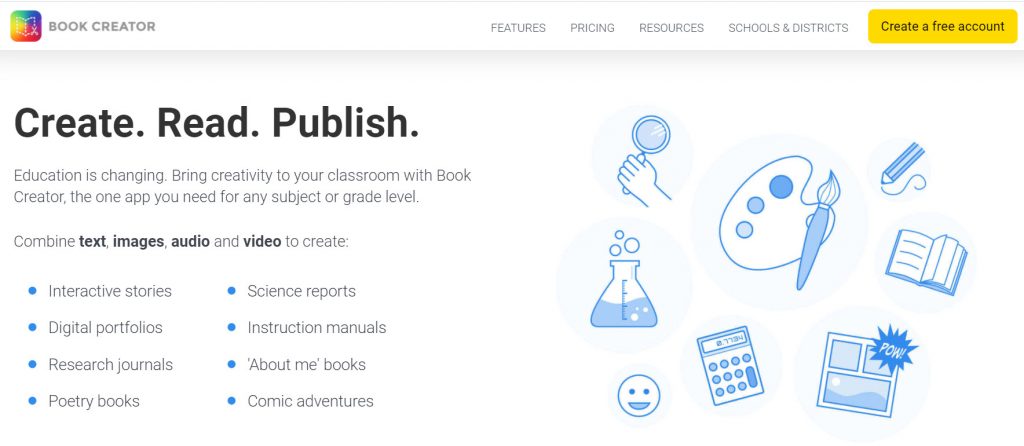
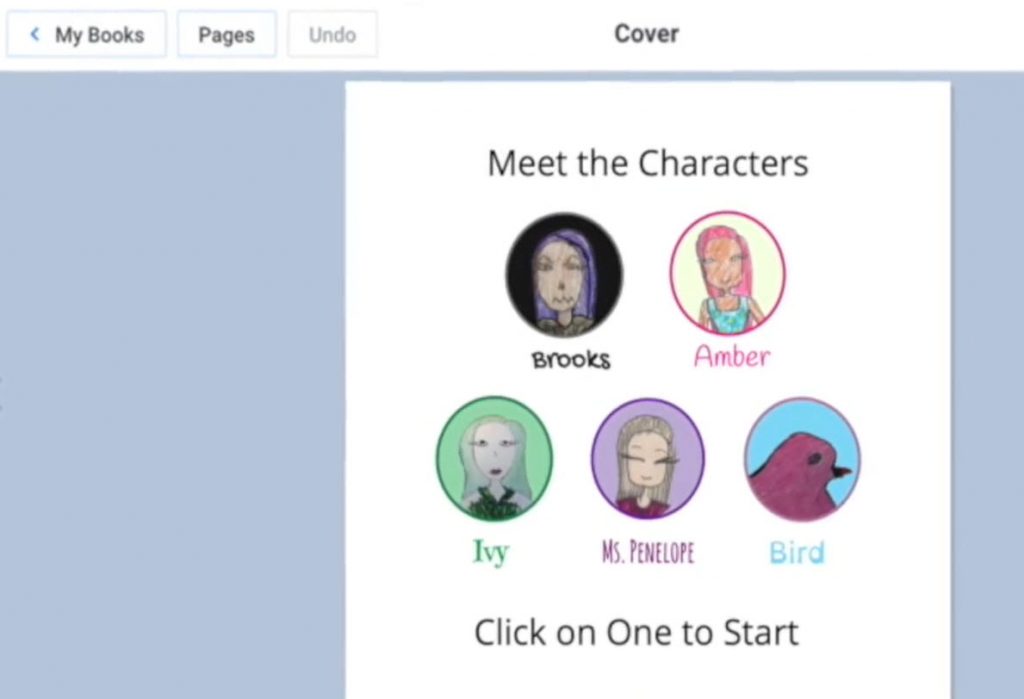
New Research: Flipped Classrooms Improve Student Academics and Satisfaction — from techlearning.com by Erik Ofgang
A new analysis of more than 317 studies found flipped classrooms to be tremendously successful although a partially flipped classroom might be best of all.
Excerpt:
In a meta analysis recently published in the Review of Educational Research, Bredow and her co-authors examined 317 high-quality studies with a combined sample size of 51,437 college students in which flipped classes were compared to traditional lecture classes taught by the same instructors. They found significant advantages for flipped versus traditional lecture in terms of academics, interpersonal outcomes, and student satisfaction.
But there were also some surprises in where and when flipped classrooms worked.
From DSC:
I love the idea of the flipped classroom due to its powerful ability to turn over more choice and more control to the students. They have much more control over the pacing of the delivery of content.
Best Document Cameras for Teachers — from echlearning.com by Luke Edwards
Get the ultimate document camera for classroom use and beyond with this guide










